Menus
- Carbon bike
- Video of the BMW HP4 Race
- What matters is by the wayside
- Notches and handlebars can be adjusted in umpteen positions
- Finally, exit pit lane, attack
- BMW HP4 Race ignites dynamic fireworks
- Spring elements respond very sensitively
- Flawless wind protection and straight-line stability
- A real superbike drive
- A piece of craftsmanship indeed

BMW
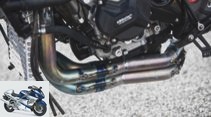
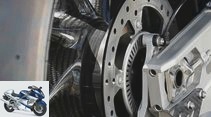
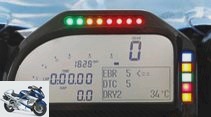
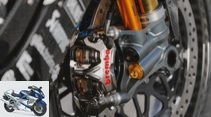
24 photos
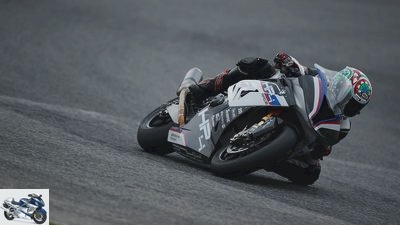
BMW
1/24
BMW HP4 Race in the driving report.
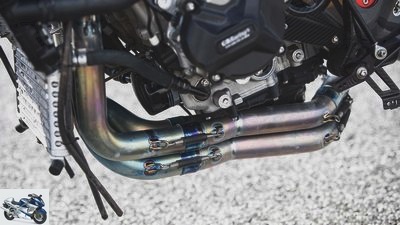
BMW
2/24
The milled oil pan creates space for the titanium manifold.
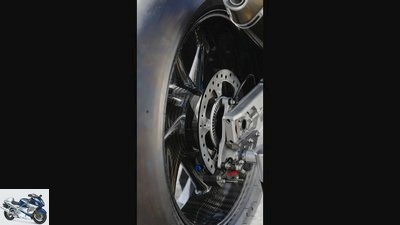
BMW
3/24
Filigree racing saddle, carbon stand mount.
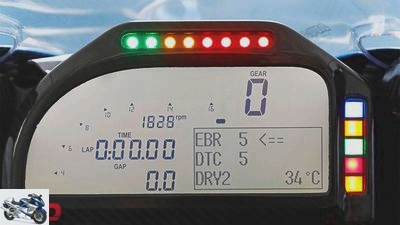
BMW
4/24
Race dashboard from 2D, easy to read, all functions are logically summarized and easy to use.
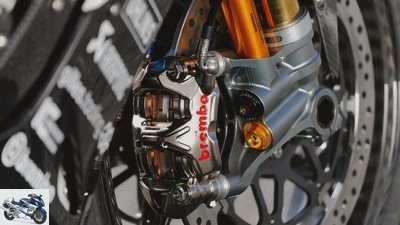
BMW
5/24
Superbikers and – when it rains – MotoGP riders use these brakes in the World Championship. A dream.
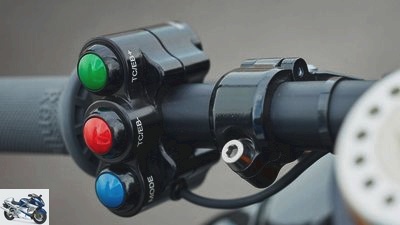
BMW
6/24
Green means more support from TC / EB, red less.
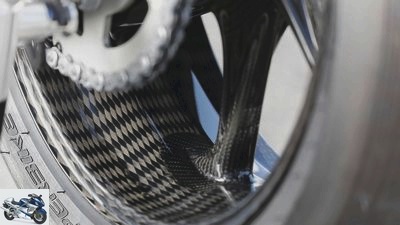
BMW
7/24
The fiber structure of the wheels is a feast for the eyes.
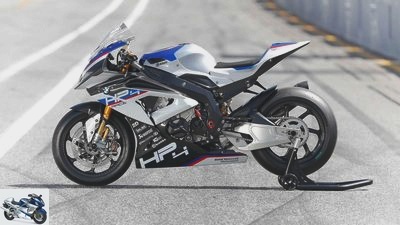
BMW
8/24
It’s all a matter of setting: the steering head angle and caster can be adjusted as well as the swing arm pivot point, notches, rear and seat height. Swing arm à la Superbike World Cup – not made of carbon – still saves 1.5 kilos.
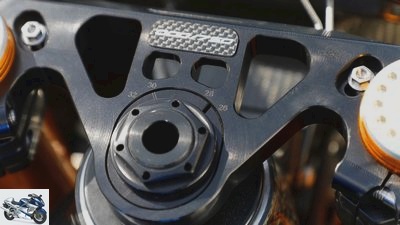
BMW
9/24
Carbon sticker with serial number, clearly visible the use of changing the offset and lag.
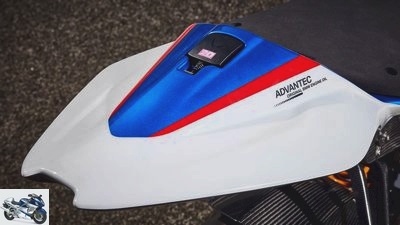
BMW
10/24
A magnet holds the GPS transmitter in place.
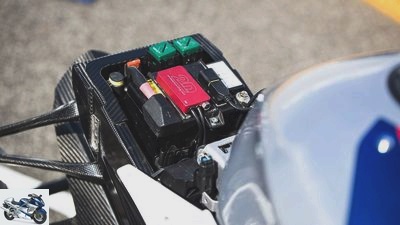
BMW
11/24
Racing wiring harness with 2D data logger, neatly framed in a carbon tub.
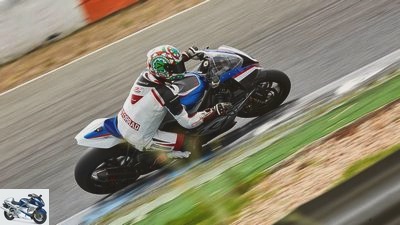
BMW
12/24
If you have 80,000 euros left and always wanted to feel like a works driver, voilà, here is the opportunity.
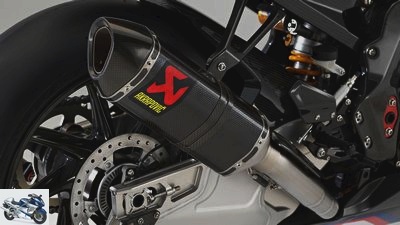
BMW
13/24
BMW HP4 Race in the driving report.
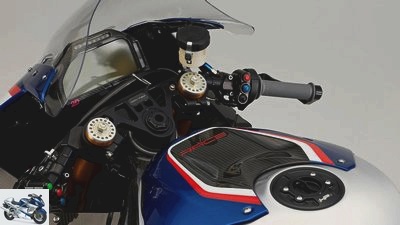
BMW
14/24
BMW HP4 Race in the driving report.
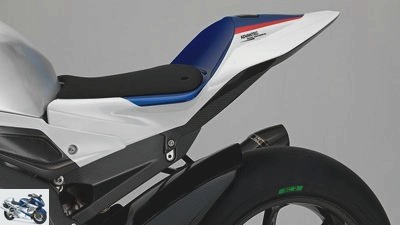
BMW
15/24
BMW HP4 Race in the driving report.
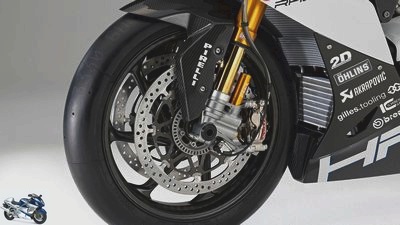
BMW
16/24
BMW HP4 Race in the driving report.

BMW
17/24
BMW HP4 Race in the driving report.
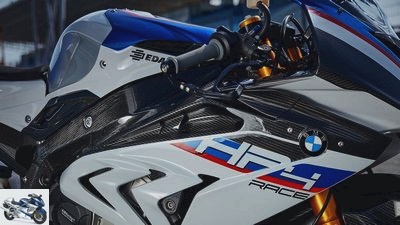
BMW
18/24
BMW HP4 Race in the driving report.
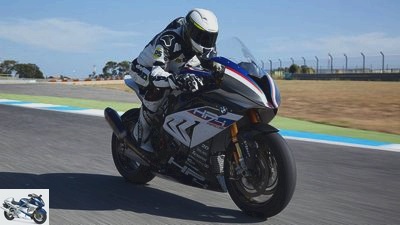
BMW
19/24
BMW HP4 Race in the driving report.

BMW
20/24
BMW HP4 Race in the driving report.
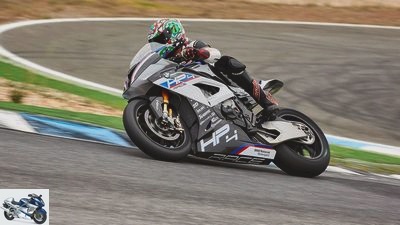
BMW
21/24
BMW HP4 Race in the driving report.
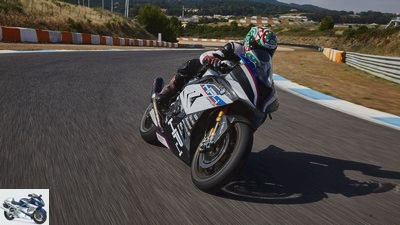
BMW
22/24
BMW HP4 Race in the driving report.
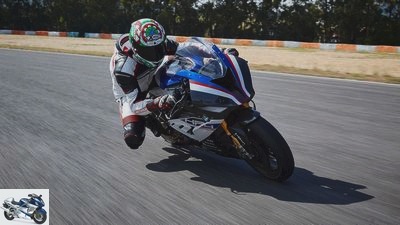
BMW
23/24
BMW HP4 Race in the driving report.
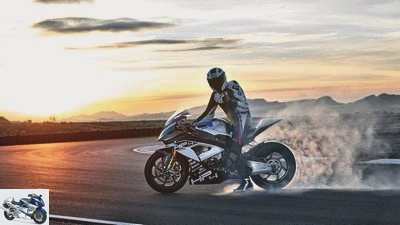
BMW
24/24
BMW HP4 Race in the driving report.
BMW HP4 Race in the driving report
Carbon bike
The finest design, sensationally low weight, finest components. BMW is pushing its limits with the BMW HP4 Race, limited to 750 pieces, with carbon frames and wheels. And one in particular: the series production of carbon frames. This gives the contact with her a very special tension.
Where do you start? The BMW HP4 Race is a single superlative. In terms of weight? 171.5 kilograms. Full tank. Dry, a ridiculous 146 kilos. That alone leaves your mouth open. In terms of performance? 215 hp. Robust, if not groundbreaking, but in connection with the low weight, 215 hp take on a whole new meaning. With suspension elements, brakes and electronics on a superbike level? At the price? Fierce, 80,000 euros, a huge announcement, but what you get for it is simply awesome. More on that later. Or maybe on the subject of carbon?
Buy complete article
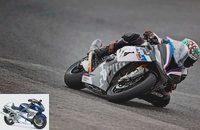
BMW HP4 Race in the driving report
Carbon bike
Know-how from Formula 1
Elmar Jager, responsible for the development of frames and wheels for the BMW HP4 Race and previously active in Formula 1, glows with enthusiasm when he talks about the frame construction. For the first time, a carbon frame was made available for industrial small-scale production, thus opening a whole new chapter. The necessary know-how was practically in-house thanks to the production of the i3 and i8 electric cars. For the frame, various mats made of continuous fibers are laid on top of one another and sewn. These so-called three-dimensional fabrics are then placed in the actual production mold, where they are finally – unlike the pre-soaked pre-preg mats – their resin injection. According to Elmar Jager, the alignment of the fiber mats can be used to specifically influence the rigidity and flex behavior of the frame.
Video of the BMW HP4 Race
What matters is by the wayside
So nothing with glass-hard, stubbornly stiff carbon frames? On the contrary. Especially since the frame of the BMW HP4 Race is made from one piece and without gluing in any cross stiffeners. Says hunter. The 7.8 kg lightweight carbon chassis saves around four kilos compared to an aluminum frame. The wheels manufactured by Thyssen-Krupp are also a treat. The entire fabric structure required for the bike is wrapped in one piece. It should reduce the moment of inertia compared to forged wheels by a massive 40 percent. Well, they can tell you a lot. But what matters is by the wayside.
Notches and handlebars can be adjusted in umpteen positions
Palpitations. What is in front of you is a flawless racing superbike. Steering head angle, caster and swing arm pivot point can be adjusted. The same is true of the rear height via an adjustable lever. The girder swing arm from the Superbike World Championship is a feast for the eyes, which according to BMW represents the optimum in terms of stiffness and weight and was therefore preferred to a carbon version. After all, she also saves a pound and a half. The self-supporting carbon hump can be screwed on in three different positions, making seat heights between 846 and 816 mm possible. The notches and handlebars of the BMW HP4 Race can be adjusted in umpteen positions. Quickshifter with blipper, race dashboard, racing wiring harness, electronics from the Superbike World Championship with launch control and adjustable engine brake, everything on board. Easy to adjust using the handlebar switch. If you want, you can use the Race-Calibration-Kit Pro to descend very far into the depths of electronics.
Finally, exit pit lane, attack
Then of course the finest Brembo stoppers. Brake calipers with titanium pistons from the Superbike World Championship, combined with 320 discs with an outer ring that is only 27 mm wide, but 6.75 mm thick and supported by a T-floater. In addition, a floating 220 mm disc on the rear wheel with small, fine four-piston pliers – of course with titanium pistons. In any case, the owner of the BMW HP4 Race can confidently save himself from rummaging through accessory catalogs. But now out on the Estoril track. The stumps sit deeper than in the series, the foam rubber seat pad provides the best possible contact with the bike, the pit lane limiter keeps the impatient sawing BMW on the speed leash as it rolls out, then finally, exit pit lane, attack.
BMW HP4 Race ignites dynamic fireworks
And what follows now is 3-D high-speed cinema in widescreen format. The BMW HP4 Race ignites dynamic fireworks that make it smoke. You don’t need to think about any lines, just fix a point, the BMW greedily pricks there. Bending, straightening up, the tricky chicane of Estoril, nothing more than a casual finger exercise. The HP4 does not give in, it pulls its pilot so irresistibly down to the deepest slopes that it almost borders on compulsion. Even bold lines can be effortlessly implemented in the apex of the curve. Brusquely erect at the exit of the curve when the accelerator is opened, the HP4 shows, however, that it is not just wearing its steering damper as an ornament. The HP4 is a brutal projectile, merciless on the brakes and when accelerating. Cheers to the sensationally low weight! Due to the fast right bend of the back straight, the HP4 bolts in a mighty incline without flinching, where the series S-1000-RR shows a clear tendency to stir despite the electronic chassis. For a direct comparison there were several RRs. And it shows painfully clearly that the HP4 is a class ahead of its base in all respects. So much so that you’d bet the two machines had nothing to do with each other. The HP4 of the S 1000 RR takes an unbelievable three seconds. Under different pilots. And it doesn’t even unduly drain the driver’s strength.
Spring elements respond very sensitively
Handling, stability, chassis, brakes, engine, the BMW HP4 Race kicks like a world championship bike. The suspension elements, above all the extremely expensive FGR 300 fork from Ohlins, work fantastically smooth and tight, respond very sensitively and do not allow any uncertainties. The feedback from the shock absorber alone is missing the last bit for the predicate “reference class". If conventional suspension elements can work so smoothly, I don’t need an electronic chassis. The brakes: a dream. The powerful deceleration can be applied with millimeter precision with two fingers, and braking far into the curve is a pleasure. Even after the third turn, the braking point is rock solid like a rock. If there is something to complain about, it is at most the occasional scratching at the end of the home stretch. It is only logical that BMW did without ABS. “We didn’t want to make any compromises and build a pure racing motorcycle", explains press spokesman Gerhard Lindner. That was more than successful.
Flawless wind protection and straight-line stability
The traction control is adjustable from plus (strong intervention) to minus seven. It does not have to be considerate of any Kat and works with ignition interventions. Level plus six corresponds roughly to the already quite sharp level minus three on the RR. Its regulation is incredibly gentle, accompanied by the crackling of the individual ignition interruptions, which provides the BMW HP4 Race driver with important acoustic feedback when the throttle is opened. It’s also great how sensitively the electronics keep the front wheel close to the ground. First cream, no comparison to the more shirt-sleeved series. So you can fire out of the almost infinitely long right-hand bend onto the home straight. Wind protection and straight-line stability are impeccable.
A real superbike drive
The four-cylinder of the BMW HP4 Race hangs tightly on the gas. Short, racetrack-compatible gear ratio (with 520 racing chain) and the low weight, together with the 215 hp, ensure powerful acceleration. Even if the four-in-line is not tuned to the teeth in terms of performance, it is still a genuine superbike drive. Basic engine and crank drive with milled Pankl steel connecting rods from the Superbike World Championship, head and valve train basically correspond to the long-distance World Championship version. That means optimized internal clearance for the lowest possible friction losses, racing gearboxes with longer first two and shorter upper three gears. Sharper camshafts, higher compression (13.9 instead of 13.0: 1) and optimized intake paths and airbox, in which larger, variable intake funnels are activated at 11,500 rpm. At this speed the HP4 sharpens its tone and noticeably increases its pressure. The end of the day with the horgy is at 14,500 rpm (series: 14,200 rpm). But far more impressive than the 215 hp is its 120 Nm torque, which is available like a plateau from 10,000 rpm. An oil pan milled from solid not only makes space for the four titanium manifolds, but also increases the supply of special racing oil by half a liter.
A piece of craftsmanship indeed
The series cooler takes care of thermal stability. He has to do without a fan. To do this, it works with a pressure of up to 1.8 bar (series: 1.2 bar), which raises the boiling point of the water above 100 degrees. One mechanic builds one engine at a time, another builds the entire motorcycle. Manufactory. Before delivery, every engine must first be run in to the test bench. Only then is it filled with fresh oil, its valve clearance corrected and, at the end, sealed. There is a 5,000 kilometer guarantee on it. Race kilometers, of course. That is enough for a hobby pilot for two seasons. Then, however, a revision is due, which is due after 2,500 kilometers at the latest if the racing engine is exhausted. The BMW HP4 Race is indeed a piece of craftsmanship. But perhaps the most fascinating thing about it, after the enthusiasm for driving has subsided, is the game of thought with series production. Which brings us back to the beginning. After all, not everyone has 80,000 euros on the high edge. But a cheaper premium version of the HP4 for the road, that would be something?
Related articles
-
Ducati Panigale Superleggera V4 in the driving report
Ducati. 19 pictures Ducati. 1/19 We had the unique opportunity to try out the new Ducati Panigale Superleggera V4. Ducati. 2/19 Much closer …
-
Kalex: company portrait and driving report
fact Kalex: Company portrait and driving report of Moto2 top manufacturer Kalex Contents of Amazing: Before their World Cup involvement in the Moto2 class, …
-
Technical driving report Boxer Team R 1100 S
Technical driving report Boxer Team R 1100 S So must be In 1998 BMW presented the sportiest series boxer of all time. But BMW fan Romolo Liebchen from…
-
Driving report MotoGP-Honda RC 212 V
2snap Driving report MotoGP-Honda RC 212 V In secret mission K photos of the engine and details, scant technical information and only two laps with…
-
Driving report: Piaggio MP3 Hybrid 125
Milagro Driving report Piaggio MP3 Hybrid 125 (2009) World’s first hybrid production two-wheeler The Italian Piaggio Group is the world’s first…
-
Aprilia RS 660 in the driving report
New items 2020 Top topic Aprilia (Alberto Cervetti). 17th photos Aprilia (Alberto Cervetti). 1/17 The new Aprilia RS 660 generated a lot of enthusiasm…
-
Driving report NCR-Ducati Millona
Bilski Driving report NCR-Ducati Millona Ease and passion The Italian company NCR has been refining Ducatis since 1969. With the Millona, the tuning…
-
Driving report Superbike factory Ducati 996
Driving report Superbike factory Ducati 996 Two wins To the disgrace of the Japanese four-cylinder squadron, Carl Fogarty celebrated the hard-won third…
-
Aprilia RSV4 RF (2015) in the driving report
Aprilia 28 photos Aprilia 1/28 Aprilia RSV4 RF. Aprilia 2/28 With the extended Race Pack, you can enjoy corner-to-corner voting for 15 European routes…
-
BMW R 1250 GS Adventure in the driving report
BMW 31 pictures BMW 1/31 The BMW R 1250 GS Adventure celebrated its premiere at the EICMA. MOTORRAD was already able to ride the Adventure GS. BMW 2/31 On …